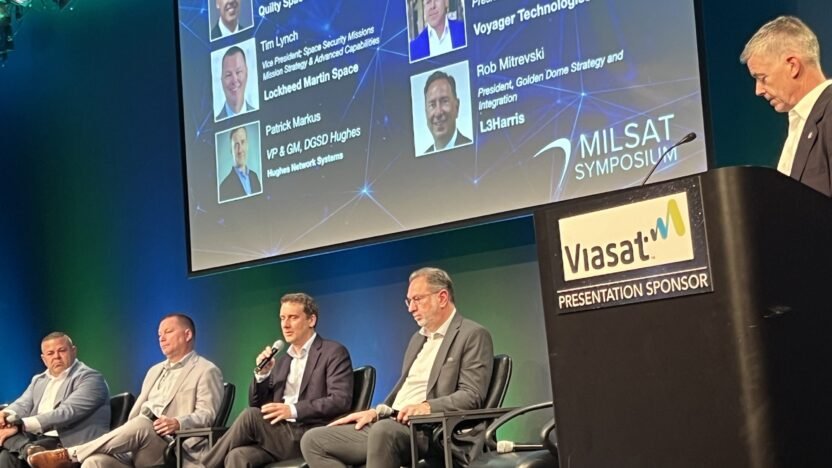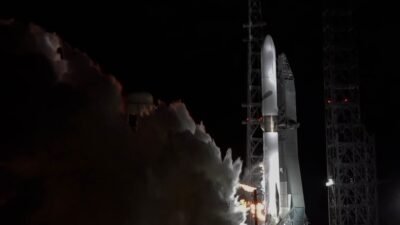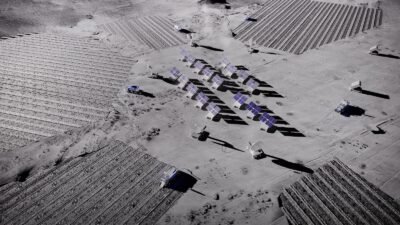MOUNTAIN VIEW, Calif. — Defense contractors are preparing to pour billions of dollars into President Trump’s signature Golden Dome missile-defense initiative even though they have received scant details from the Pentagon about the program’s technical requirements and architecture.
During a panel discussion Oct. 30 at the MilSat Symposium, executives discussed their strategies amid a lack of program details and the drag of a prolonged government shutdown.
Even though Congress has already appropriated nearly $25 billion to get Golden Dome started, “the holistic architecture hasn’t been shared with anyone in industry at this point,” said Tom Barton, CEO and co-founder of Antaris, a defense contractor focused on modeling and simulation technologies that works with the Missile Defense Agency.
The information vacuum comes at a particularly challenging time, as the ongoing government shutdown has frozen funding allocations and disrupted program timelines, adding another layer of complexity to companies’ investment decisions.
Political risk
Another potential concern for contractors is whether Golden Dome will survive beyond the president’s term. The question was posed bluntly by Chris Quilty, chief executive of market research firm Quilty Space, during the symposium panel.
“It’s been said that no government program ever dies,” noted Quilty. But he posited a hypothetical regarding the program’s long-term future: “What are the odds that you have to weigh internally that, because this is a Trump directed program that, come 2028, all these efforts will come to a screeching halt?”
The stakes are enormous. Space and defense firms are positioning to compete for what is expected to be a massive procurement of satellites for the space-based interceptor layer of Golden Dome. In January, the White House published an executive order directing development of a multi-layered missile defense architecture that explicitly calls for deploying “proliferated” space-based interceptors — not just a handful, but enough to ensure reliable coverage.
These space-based systems would represent a massive leap in missile defense technology. Unlike existing ground and sea-based systems that engage threats during midcourse or terminal phases — often after warheads have separated and countermeasures deployed — space-based interceptors operating from orbit would be positioned to detect launches, receive fire-control commands and respond within seconds, ideally neutralizing missiles before they leave adversary airspace or release additional threats or decoys.
Hedging bets
Defense contractors are adopting different strategies to manage political and programmatic risks. Tim Lynch, vice president of mission strategies and advanced capabilities at Lockheed Martin, the nation’s largest defense contractor, said his company is developing technologies that could serve multiple purposes beyond Golden Dome.
“You have to have an ability to pivot,” said Lynch. Lockheed Martin views technologies being developed for Golden Dome as providing “enterprise value type capabilities” applicable to other programs. “And if this starts slowing up, or architectures pivot a bit, you put that in a different parcel, or a different capability, or a different pocket for our warfighter,” he said.
“You have to be able to have that flexibility in your value proposition that gives you some safety net in your investments,” Lynch added.
L3Harris has taken a proactive stance, already investing half a billion dollars to scale up technology development and manufacturing across the United States, according to Rob Mitrevski, president of Golden Dome strategy and integration at the company.
“You’re looking for the demand signal, but it’s a bit of a trap, because if you wait for the demand signal, you’re not going to have the scale in time,” said Mitrevski. “So what we’ve done is some calculus about where the demand signal will come, and we’ve invested in those areas. Because in the end, all of this vision and so forth is really going to be measured by results and capability.”
Commercial players
The Golden Dome opportunity is also attracting commercial space companies that see potential for dual-use technologies. Patrick Markus, vice president and general manager of Hughes Network Systems, said his company is focusing on ground systems and networking capabilities that could serve both military and commercial markets.
“When we look at the multiple layers of Golden Dome and all of the communication networks that are involved, how do you stitch all that together and orchestrate that into one seamless environment? So that’s the area that we’re primarily focused on,” Markus explained.
Voyager Technologies went public this summer and is seeking to position itself for Golden Dome opportunities. The company manufactures space electronics, sensors, guidance and navigation systems, propulsion systems and is developing AI tools to support missile detection, according to Matt Magaña, president of defense and national security at Voyager.
“And I think there’s a lot of folks that are obviously shifting the balance sheet heavily in this area” to support the program, Magaña said. However, he noted that capital markets demand companies close a business case “whether that contract comes or not,” and investors need some assurances there will be returns.
Budget uncertainty
The protracted government shutdown that is about to enter its second month has emerged as an immediate concern overshadowing even the longer-term political questions.
“The biggest worry that I think most of us have right now is around budget,” said Magaña. The capital markets are ready to invest, but they need to see “budgets put in place and understand what the forecast is on those things, so that we can actually bring the dollars to bear.”
The shutdown’s impact is already being felt across the supply chain. “There’s a lot of strain on the system where investment wants to come in … but it’s also hard to close those deals financially when the budgets aren’t out there,” Magaña added. Companies need funding stability so “we can continue to invest in supply chains,” he said. “So the budget right now is probably my biggest worry.”
Defining the problem
When asked about the affordability of Golden Dome, Mitrevski highlighted a definitional problem.
“Define what it is,” he said. “We need to see the architecture to answer the question. We have a lot of capability currently in our nation. It’s this focus of tying it together. So the question still remains, what is Golden Dome?”
Despite the uncertainties, executives expressed confidence that some form of advanced missile defense system will survive regardless of political changes. Barton of Antaris was particularly optimistic: “I think he’s going to survive,” he said, noting that the Missile Defense Agency existed long before Golden Dome. “And so if the ideas are good enough and the integration capability and architecture is good enough, and if the threat continues to exist, I think that Golden Dome is going to survive in some kind of form.”
Mitrevski echoed this sentiment: “If you change the word Golden Dome to missile defense architecture, do you think that lasts past 2028? The answer is, of course it will. It’s a missile defense architecture.”
New procurement paradigm
The Pentagon appears to be abandoning traditional procurement methods for Golden Dome, according to Lynch. “The procurement paradigm has changed drastically in the last few years,” he said. “Customers expect you to be able to deliver at speed.”
Under the traditional model, the government would issue a solicitation, select a contractor to develop a system under a cost-reimbursable contract, followed by years of reviews.
“We’re investing quite heavily into having capability that’s ready now,” said Lynch. “We’re talking about a year, 18 months. The cost-plus mentality is kind of waning a bit, and the fixed price and the product centric type procurements are pretty strong in our ecosystem.”
For now, industry executives are counseling patience as they navigate the uncertainty. “People are going to have to have patience,” said Barton. “There’s a lot of questions, and of course, you should have questions, and I believe that they will be answered over time.”




